Rio de Janeiro - Final Draft
I'll warn you right now that this post will be very long. If you don't want to read everything about our trip you can just browse the pictures and read the section above it for the play-by-play of that particular event. Also, I'll be updating it in chunks and I'll change the title of the blog entry to draft 2, 3...etc as I add to it and polish it up. So here it goes...
Overall, our vacation to Rio was awesome. In 8 days we saw a ton of the city and surrounding area. It is an amazing place with lots of culture, beauty, and excitement.
On Saturday, November 12 we arrived at about 8 am after a relatively easy flight and we got to our hotel around 10 am. We checked in and took a nap to recover from the overnight flight and then headed to Copacabana beach in the afternoon. It was warm but cloudy and it sprinkled a couple of times. We took a stroll up the beach and went to Forte de Copacabana, an old military base from around WWI that was very well preserved and had a great view of the beach.

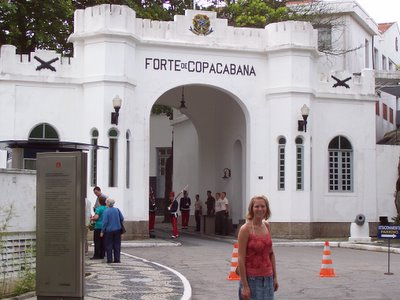


Erin had found out that there were Samba rehearsals (practice sessions for Carnival) on Saturday nights. The Samba schools were generally not in the best areas so we didn´t just want to take a cab there but we also didn´t want to pay the hugely inflated tour cost. So after negotiating with our semi-english speaking hotel concierge we got him to talk a driver into taking us there, helping us buy the tickets, drop us off at the door, and pick us up from the door at whatever time we wanted. So we got to the Samba school at about midnight and the street and gymnasium were packed with people. The Samba rehearsal was cool. There was a group of about 75 people playing drums and various other instruments and they were very good. The entire gymnasium was full of people dancing and chatting. At times they would clear a path down the middle and a group of dancers would come through. We stayed until 3 am and when we left the entire complex was so crowded that you could hardly move. Outside there were still tons of people too. Apparently these Samba rehearsals basically go all night and happen every Saturday from September until February.


On Sunday we went to a "hippy fair"´and bought a few things before heading to Ipanema beach. This beach is gorgeous and probably the most popular. It was packed with people laying out, playing soccer, and playing paddleball. We laid out for awhile and took a walk.

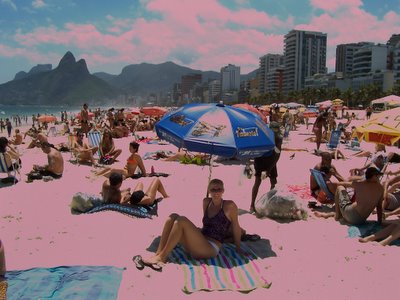
In the evening we went to Sugar loaf, which is a mountain that sticks up out of the Rio Bay and overlooks the city. We took the cable car (like a gondola) to the top and were able to watch the sunset. I was a little disappointed at the time that we were there in the later evening once the whole city was in the shadows of the mountains, but it turned out to be the most picturesque part of the trip.
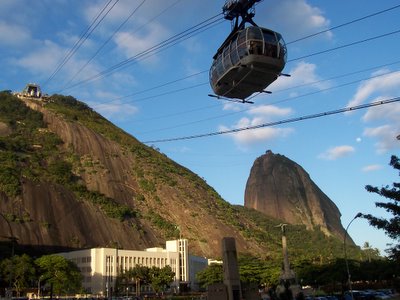

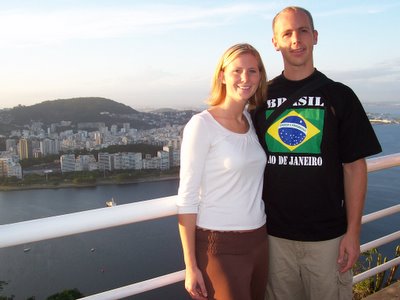


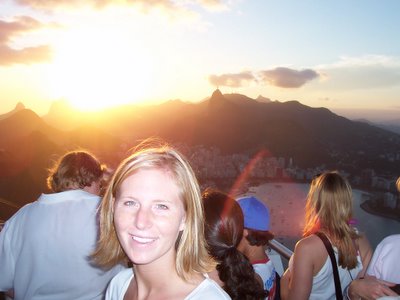
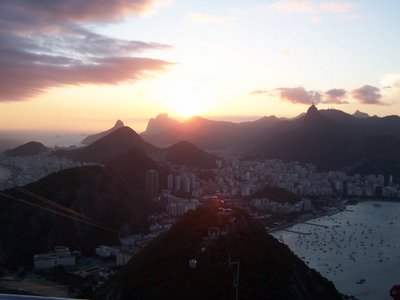


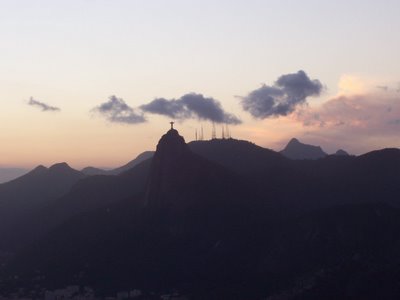
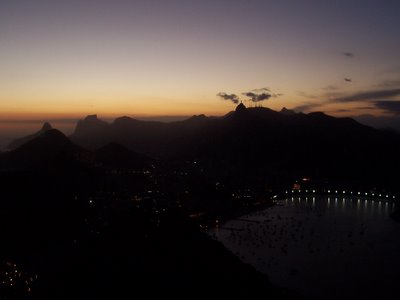

On Monday we took a tour that showed us their huge soccer stadium, Manacana,

the street where they do the competition part of Carnival,



a famous cathedral,
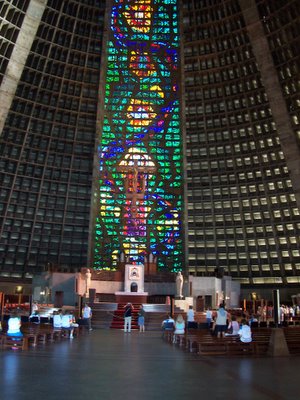
and finally the Christ statue on top of Corcovado. The Christ stature is a better city view than any other vantage point I´ve ever been to (and I go to as many as I can). It is definately one of the best city views in the world. Rio is such a beautiful city, both the city layout and the natural lanscape with all the mountains, beaches, the bay and the islands. Plus, the mountain where the statue sits is about 2300 feet high, which is much taller than any building in the world. The statue itself is pretty simple and stands 100 feet tall.
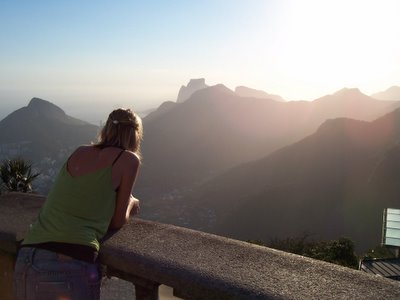
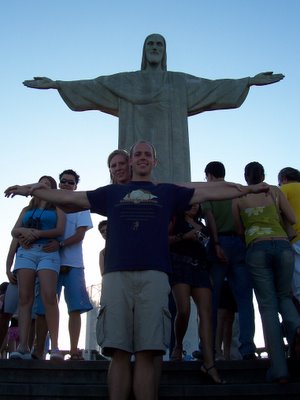
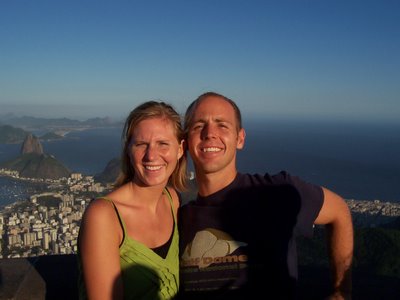



On Tuesday we went across the bay to a city called Niteroi to visit with Jenny Scott´s cousin Michelle and her husband Fabiano. They are Niteroi natives and also speak pretty good English. We had a great day with them. They first showed us a couple of their favorite beaches and then we went to a modern art museum which overlooks Niteroi and the skyline of Rio. A funny thing happened in the museum. The very first exhibit we saw was a big version of one of those puzzles where you move one piece at a time until it is in the right order to make the picture. Naturally, I'm a fan of those puzzles so I wanted to do it. Momentarily forgetting I was in a modern art museum I reached up to start moving the pieces and as I did Fabiano quickly told me not to. As he did about 3 museum workers began sprinting in our direction to stop me from touching the art. Luckily Fabiano had spoken just soon enough so I didn't actually touch it (less than an inch) and the museum workers stopped running at me and just glared. For the rest of the time that we were in the museum there was a worker tailing us and staring directly at me (rightfully so). In the evening they took us back to their apartment and we swam in their pool on the roof of the building, which had a view of the Rio skyline. They were a lot of fun and it was neat to be able to talk to them about what Brazil is like.

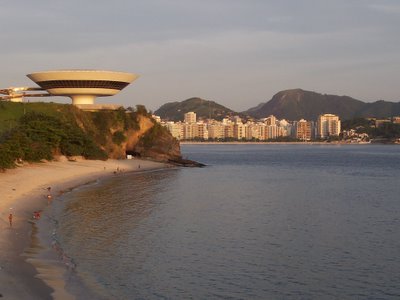
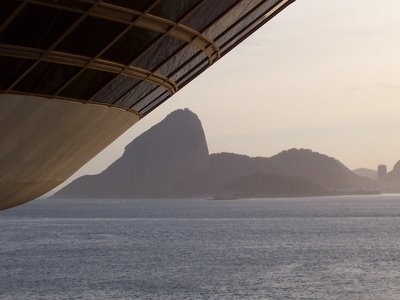
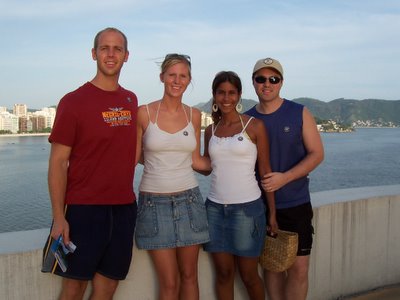
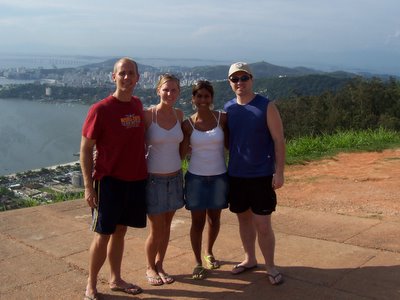
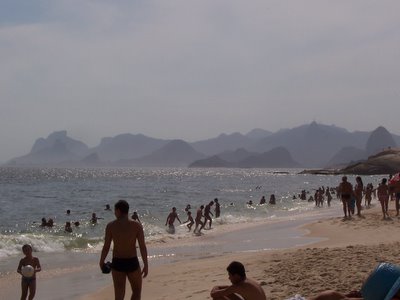

On Wednesday I talked Erin into doing something that I've always wanted to do - go hang gliding. Rio is perfect for hang gliding because of the ocean breezes, the steep hills and the awesome scenery. We decided not to tell our mothers about it beforehand so that they wouldn't worry and didn't have a chance to try to talk us out of it. The launch point is about 1700 feet above the beach and basically you are harnessed in with a guide and have to run down a 20 foot ramp and take a leap of faith. It was great. Once air born it was a very peaceful ride at about 20 mph as we went over the forest, over a part of the city, over the beach, and over the ocean before landing on the sand.

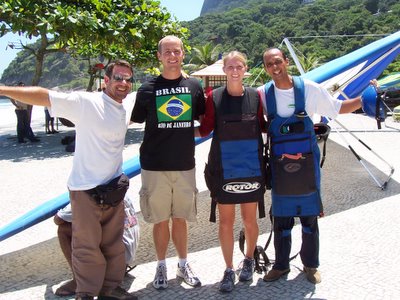
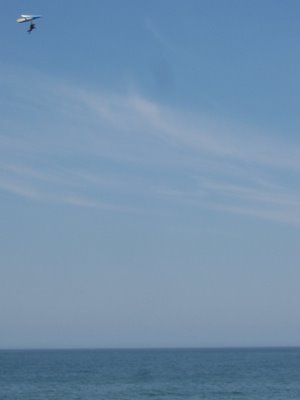


Later in the day we went to Rio's botanical garden which was very nice. The fauna was impressive but there wasn't much wildlife. We were told we'd see monkeys.
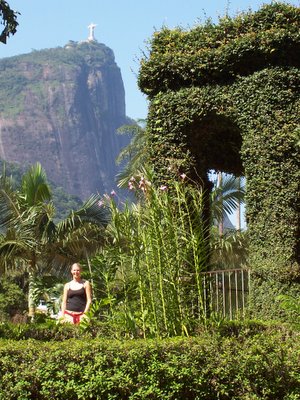


On Thursday we took a trip out of the city to Petropolis. Petropolis is a city in the mountains about 50 miles away that held the palace of the emperor in the 1800's before the Republic was formed.
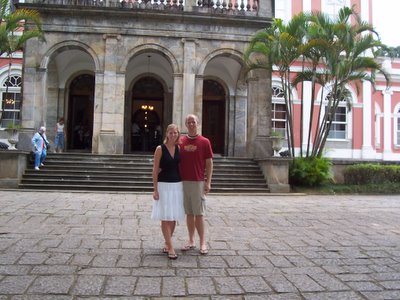

On Friday we spent some more time on the beach to work on our tan before taking an afternoon tour to a couple of Favelas. This was the most interesting and informative tour we took. A favela can be translated into a shantytown. Approximately 20% of the population lives in one of the 740 favelas in Rio. They began forming as temporary homes about 100 years ago but obviously became much more permanant. These favelas form on the hillsides on land that is usually owned by the church or govermnent. Until about 10 years ago they weren't recognized by the govermnent as even existing even though they were home to 1 million residents. Through the 1960's they were very high in crime, disease, and drugs. However, at that time a group of guerrila militants formed in opposition of the government. Throughout that struggle a lot of them ended up in the same jails as the drug dealers and they tried to persuade the drug dealers to join up with them. In the end all they did was teach the drug dealers how to form an effective and powerful organization. Through this new knowledge 3 primary drug groups formed and these took over all the favelas. Interestingly, the favelas were improved by this formation. Since one organization would own an entire favela there would be peace (except when favelas owned by different groups would go to war). And each organization made it a rule that no one could steal from anyone else while in the favela because that would be a reason for the police to enter and get in the way of their drug business. One theft usually means a broken bone and if you steal twice? That WILL be your last time. While the drug organizations did help with the crime in the favelas, they did not help with the disease. Until the governement began recognizing the favelas they did not have electricity, running water, sewage, or trash pickup. Finally, in 1993 a plan was put in place by city hall to start including the favelas as part of the city and now most have electricity, water, sewage, trash, schools, and health centers. However, they are still the home to the poverty-stricken and they are where Brazil's primary drug trafficing takes place.
At night we went to Lapa, which is near downtown and where a lot of night life is. We went to a cool bar with live music and then saw Rio's aquaduct.

Saturday was our last day in the city. We headed back to Ipanema for some final beach time
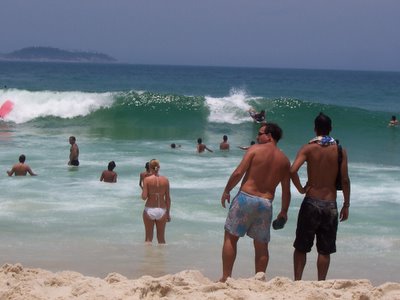


and then went to explore downtown a bit. The city was founded in the 1500s so it has quite a bit of history but we could only walk by the old buildings and read about their significance in our travel book. A walking tour would have been nice but they don't seem to exist.
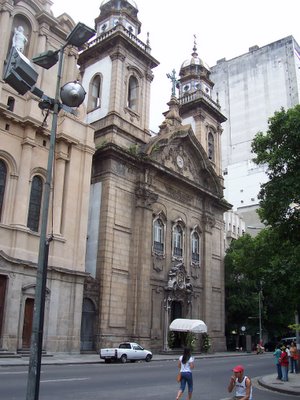
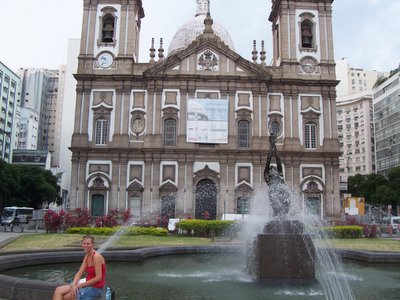
Sadly, we eventually had to head home :(

Well that was the jist of what we did while there but there was so much more that we actually experienced. For the next section I'll take a look at some different aspects of Rio de Janeiro that we experienced every day and not just in a certain event.
CURRENCY - Everything was more expensive that we thought. Basically prices were the same as here. A big reason why is that the US Dollar has slipped by 50% to the Brazillian Real over the last 18 months. It was trading at about 2.15:1 while we were there compared to 3.2:1 in the spring of 2004 and over 4:1 in 2002.
BEACHES - Every physical need you have can be met while sitting on the beach. There is a constant string of salesmen walking around selling drinks, food, sunscreen, hats, bikinis, sunglasses, bracelets, necklesses, and a ton of other stuff as well as renting out things like sun unbrellas and lounge chairs. For the most part it was nice because you didn't have to get up to get a drink or anything but sometimes it was annoying when a salesman would get too aggressive and wouldn't leave you alone after you said no.
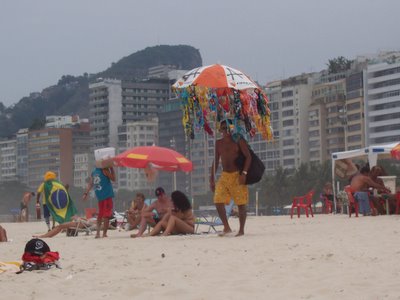
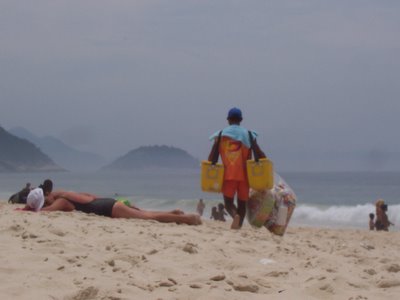
LANGUAGE - The main language is portugese and we struggled with this at times. Erin speaks a little Spanish but the two are different enough that if the person we were trying to talk to didn't speak spanish as well as portugese it wouldn't work. Some people spoke English but not that many so we had our fair share of language barriers but in the end we always just laughed about it afterward.
RESTAURANTS - One common trend I noticed in their restaurants would be that each person would get a card with all the restaurant's meals and beverages listed on it. Then, as you ordered the waiter would mark them off on your card. When you paid they would use your card to add up the bill and then give you a piece of the card with a marking on it saying you paid. As you walked out the door of the restaurant a person would be sitting there and you'd have to give them that piece of the card to prove you'd paid.
There were two unique types of restaurants in Rio that were popular. One was called a Kilograma. It is basically a buffet but after you fill up your plate you bring it to a scale and pay based on the weight of your food. I liked it. My average plate was bout 0.62 kg. The other unique type of restaurant was a churrascaria. This was also similar to a buffet. You paid a fixed price for the meal and there was a buffet line for the side dishes but the meat was brought directly to your table. Each person has a card that is red on one side and green on the other. If you want meat you put it on the green side and waiters walking around with different kinds of meet come and ask you if you'd like any. We went to a very nice churrascaria and they had at least 15 different kinds of meat ranging from osterich to t-bone. Excellent!
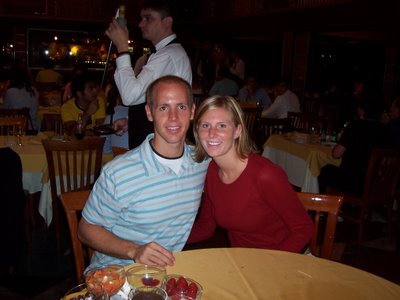
SERVICE - The service industry seemed very overstaffed to me. At clothing stores, every shopper would have a salesperson standing 3 feet away just waiting to answer any question you might have. At restaurants it seemed we always had our own personal waiter. When we wanted anything, we'd just turn around and ask. We never had to waive anyone down.
DRIVING - It seems driving in all other countries is much less regulated than the US but this was the worst I've seen. Lanes do not exist and neither to blinkers. When you want to move you just go and if you hear a honk then you'd better wait a few seconds before you do. After 10pm 50% of red lights are regarded as stop signs that can be driven through if the driver feels like it. After midnight all redlights are treated this way. Honking is more common than using a turn signal.
PUBLIC TRANSPORTATION - There were busses everywhere but no maps of the bus route so basically you just had to know where exactly they went. Obviously this was a problem for us but once we figure the main lines out they were very efficient ways to travel. The subway was quite new and there was a stop right across the street from our hotel. Unfortunately that stop was the end of the line so we could only take the subway if we wanted to go toward downtown and a lot of the sights we saw were the other direction. Cabs were also everywhere but a couple of times they deliberately went out of the way. We knew what they were doing but when we tried to yell at them they'd just yell back in a different language.
GESTURES - Thumbs up was very common. We saw that all the time and not just to bridge the language barrier.
PDA - Public displays of affection were all over the place. We commonly saw a couple just completely making out in public. At the samba school it was out of control but even at the beach or at a restaurant a random couple would break out in a big make out session.
Funny quotes:
"Gringo Bambino" Said by a salesman on the street trying to get me to buy a spongebob squarepants stuffed animal knockoff. Gringo is a derogatory word for white tourist that I would equate to 'honkey' and bambino we think meant child. So he wanted us to buy the spongebob for our honkey child.
"We can hear you calling us Gringos" Erin to a McDonals worker that was obviously mocking us
"I am white...and she is brown" Fabiano explaining what he and Michelle looked like so that we could identify them when we got off the bus
"Give me money" The only english words that a lot of the children know. Seems like they could play the sympathy angle a little better
Overall, our vacation to Rio was awesome. In 8 days we saw a ton of the city and surrounding area. It is an amazing place with lots of culture, beauty, and excitement.
On Saturday, November 12 we arrived at about 8 am after a relatively easy flight and we got to our hotel around 10 am. We checked in and took a nap to recover from the overnight flight and then headed to Copacabana beach in the afternoon. It was warm but cloudy and it sprinkled a couple of times. We took a stroll up the beach and went to Forte de Copacabana, an old military base from around WWI that was very well preserved and had a great view of the beach.




Erin had found out that there were Samba rehearsals (practice sessions for Carnival) on Saturday nights. The Samba schools were generally not in the best areas so we didn´t just want to take a cab there but we also didn´t want to pay the hugely inflated tour cost. So after negotiating with our semi-english speaking hotel concierge we got him to talk a driver into taking us there, helping us buy the tickets, drop us off at the door, and pick us up from the door at whatever time we wanted. So we got to the Samba school at about midnight and the street and gymnasium were packed with people. The Samba rehearsal was cool. There was a group of about 75 people playing drums and various other instruments and they were very good. The entire gymnasium was full of people dancing and chatting. At times they would clear a path down the middle and a group of dancers would come through. We stayed until 3 am and when we left the entire complex was so crowded that you could hardly move. Outside there were still tons of people too. Apparently these Samba rehearsals basically go all night and happen every Saturday from September until February.


On Sunday we went to a "hippy fair"´and bought a few things before heading to Ipanema beach. This beach is gorgeous and probably the most popular. It was packed with people laying out, playing soccer, and playing paddleball. We laid out for awhile and took a walk.


In the evening we went to Sugar loaf, which is a mountain that sticks up out of the Rio Bay and overlooks the city. We took the cable car (like a gondola) to the top and were able to watch the sunset. I was a little disappointed at the time that we were there in the later evening once the whole city was in the shadows of the mountains, but it turned out to be the most picturesque part of the trip.












On Monday we took a tour that showed us their huge soccer stadium, Manacana,

the street where they do the competition part of Carnival,



a famous cathedral,

and finally the Christ statue on top of Corcovado. The Christ stature is a better city view than any other vantage point I´ve ever been to (and I go to as many as I can). It is definately one of the best city views in the world. Rio is such a beautiful city, both the city layout and the natural lanscape with all the mountains, beaches, the bay and the islands. Plus, the mountain where the statue sits is about 2300 feet high, which is much taller than any building in the world. The statue itself is pretty simple and stands 100 feet tall.






On Tuesday we went across the bay to a city called Niteroi to visit with Jenny Scott´s cousin Michelle and her husband Fabiano. They are Niteroi natives and also speak pretty good English. We had a great day with them. They first showed us a couple of their favorite beaches and then we went to a modern art museum which overlooks Niteroi and the skyline of Rio. A funny thing happened in the museum. The very first exhibit we saw was a big version of one of those puzzles where you move one piece at a time until it is in the right order to make the picture. Naturally, I'm a fan of those puzzles so I wanted to do it. Momentarily forgetting I was in a modern art museum I reached up to start moving the pieces and as I did Fabiano quickly told me not to. As he did about 3 museum workers began sprinting in our direction to stop me from touching the art. Luckily Fabiano had spoken just soon enough so I didn't actually touch it (less than an inch) and the museum workers stopped running at me and just glared. For the rest of the time that we were in the museum there was a worker tailing us and staring directly at me (rightfully so). In the evening they took us back to their apartment and we swam in their pool on the roof of the building, which had a view of the Rio skyline. They were a lot of fun and it was neat to be able to talk to them about what Brazil is like.







On Wednesday I talked Erin into doing something that I've always wanted to do - go hang gliding. Rio is perfect for hang gliding because of the ocean breezes, the steep hills and the awesome scenery. We decided not to tell our mothers about it beforehand so that they wouldn't worry and didn't have a chance to try to talk us out of it. The launch point is about 1700 feet above the beach and basically you are harnessed in with a guide and have to run down a 20 foot ramp and take a leap of faith. It was great. Once air born it was a very peaceful ride at about 20 mph as we went over the forest, over a part of the city, over the beach, and over the ocean before landing on the sand.





Later in the day we went to Rio's botanical garden which was very nice. The fauna was impressive but there wasn't much wildlife. We were told we'd see monkeys.



On Thursday we took a trip out of the city to Petropolis. Petropolis is a city in the mountains about 50 miles away that held the palace of the emperor in the 1800's before the Republic was formed.


On Friday we spent some more time on the beach to work on our tan before taking an afternoon tour to a couple of Favelas. This was the most interesting and informative tour we took. A favela can be translated into a shantytown. Approximately 20% of the population lives in one of the 740 favelas in Rio. They began forming as temporary homes about 100 years ago but obviously became much more permanant. These favelas form on the hillsides on land that is usually owned by the church or govermnent. Until about 10 years ago they weren't recognized by the govermnent as even existing even though they were home to 1 million residents. Through the 1960's they were very high in crime, disease, and drugs. However, at that time a group of guerrila militants formed in opposition of the government. Throughout that struggle a lot of them ended up in the same jails as the drug dealers and they tried to persuade the drug dealers to join up with them. In the end all they did was teach the drug dealers how to form an effective and powerful organization. Through this new knowledge 3 primary drug groups formed and these took over all the favelas. Interestingly, the favelas were improved by this formation. Since one organization would own an entire favela there would be peace (except when favelas owned by different groups would go to war). And each organization made it a rule that no one could steal from anyone else while in the favela because that would be a reason for the police to enter and get in the way of their drug business. One theft usually means a broken bone and if you steal twice? That WILL be your last time. While the drug organizations did help with the crime in the favelas, they did not help with the disease. Until the governement began recognizing the favelas they did not have electricity, running water, sewage, or trash pickup. Finally, in 1993 a plan was put in place by city hall to start including the favelas as part of the city and now most have electricity, water, sewage, trash, schools, and health centers. However, they are still the home to the poverty-stricken and they are where Brazil's primary drug trafficing takes place.
At night we went to Lapa, which is near downtown and where a lot of night life is. We went to a cool bar with live music and then saw Rio's aquaduct.

Saturday was our last day in the city. We headed back to Ipanema for some final beach time



and then went to explore downtown a bit. The city was founded in the 1500s so it has quite a bit of history but we could only walk by the old buildings and read about their significance in our travel book. A walking tour would have been nice but they don't seem to exist.


Sadly, we eventually had to head home :(

Well that was the jist of what we did while there but there was so much more that we actually experienced. For the next section I'll take a look at some different aspects of Rio de Janeiro that we experienced every day and not just in a certain event.
CURRENCY - Everything was more expensive that we thought. Basically prices were the same as here. A big reason why is that the US Dollar has slipped by 50% to the Brazillian Real over the last 18 months. It was trading at about 2.15:1 while we were there compared to 3.2:1 in the spring of 2004 and over 4:1 in 2002.
BEACHES - Every physical need you have can be met while sitting on the beach. There is a constant string of salesmen walking around selling drinks, food, sunscreen, hats, bikinis, sunglasses, bracelets, necklesses, and a ton of other stuff as well as renting out things like sun unbrellas and lounge chairs. For the most part it was nice because you didn't have to get up to get a drink or anything but sometimes it was annoying when a salesman would get too aggressive and wouldn't leave you alone after you said no.


LANGUAGE - The main language is portugese and we struggled with this at times. Erin speaks a little Spanish but the two are different enough that if the person we were trying to talk to didn't speak spanish as well as portugese it wouldn't work. Some people spoke English but not that many so we had our fair share of language barriers but in the end we always just laughed about it afterward.
RESTAURANTS - One common trend I noticed in their restaurants would be that each person would get a card with all the restaurant's meals and beverages listed on it. Then, as you ordered the waiter would mark them off on your card. When you paid they would use your card to add up the bill and then give you a piece of the card with a marking on it saying you paid. As you walked out the door of the restaurant a person would be sitting there and you'd have to give them that piece of the card to prove you'd paid.
There were two unique types of restaurants in Rio that were popular. One was called a Kilograma. It is basically a buffet but after you fill up your plate you bring it to a scale and pay based on the weight of your food. I liked it. My average plate was bout 0.62 kg. The other unique type of restaurant was a churrascaria. This was also similar to a buffet. You paid a fixed price for the meal and there was a buffet line for the side dishes but the meat was brought directly to your table. Each person has a card that is red on one side and green on the other. If you want meat you put it on the green side and waiters walking around with different kinds of meet come and ask you if you'd like any. We went to a very nice churrascaria and they had at least 15 different kinds of meat ranging from osterich to t-bone. Excellent!

SERVICE - The service industry seemed very overstaffed to me. At clothing stores, every shopper would have a salesperson standing 3 feet away just waiting to answer any question you might have. At restaurants it seemed we always had our own personal waiter. When we wanted anything, we'd just turn around and ask. We never had to waive anyone down.
DRIVING - It seems driving in all other countries is much less regulated than the US but this was the worst I've seen. Lanes do not exist and neither to blinkers. When you want to move you just go and if you hear a honk then you'd better wait a few seconds before you do. After 10pm 50% of red lights are regarded as stop signs that can be driven through if the driver feels like it. After midnight all redlights are treated this way. Honking is more common than using a turn signal.
PUBLIC TRANSPORTATION - There were busses everywhere but no maps of the bus route so basically you just had to know where exactly they went. Obviously this was a problem for us but once we figure the main lines out they were very efficient ways to travel. The subway was quite new and there was a stop right across the street from our hotel. Unfortunately that stop was the end of the line so we could only take the subway if we wanted to go toward downtown and a lot of the sights we saw were the other direction. Cabs were also everywhere but a couple of times they deliberately went out of the way. We knew what they were doing but when we tried to yell at them they'd just yell back in a different language.
GESTURES - Thumbs up was very common. We saw that all the time and not just to bridge the language barrier.
PDA - Public displays of affection were all over the place. We commonly saw a couple just completely making out in public. At the samba school it was out of control but even at the beach or at a restaurant a random couple would break out in a big make out session.
Funny quotes:
"Gringo Bambino" Said by a salesman on the street trying to get me to buy a spongebob squarepants stuffed animal knockoff. Gringo is a derogatory word for white tourist that I would equate to 'honkey' and bambino we think meant child. So he wanted us to buy the spongebob for our honkey child.
"We can hear you calling us Gringos" Erin to a McDonals worker that was obviously mocking us
"I am white...and she is brown" Fabiano explaining what he and Michelle looked like so that we could identify them when we got off the bus
"Give me money" The only english words that a lot of the children know. Seems like they could play the sympathy angle a little better
1 Comments:
sweet, I'm glad you got to hang out with my cousin...doesn't Brazil have the best views? have you had pao de queijo yet? allrighty, can't wait to hear the rest of your adventures
Post a Comment
<< Home